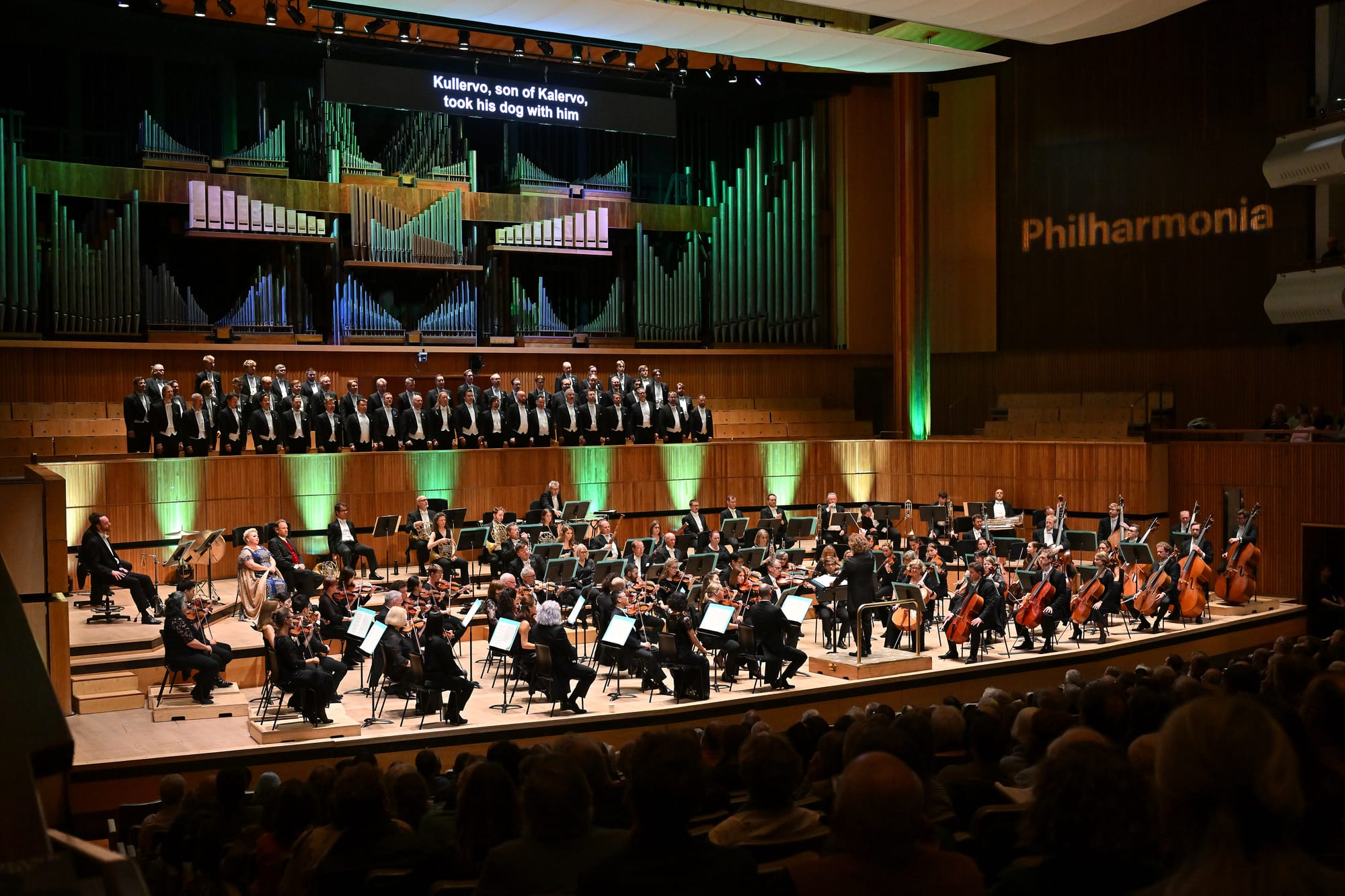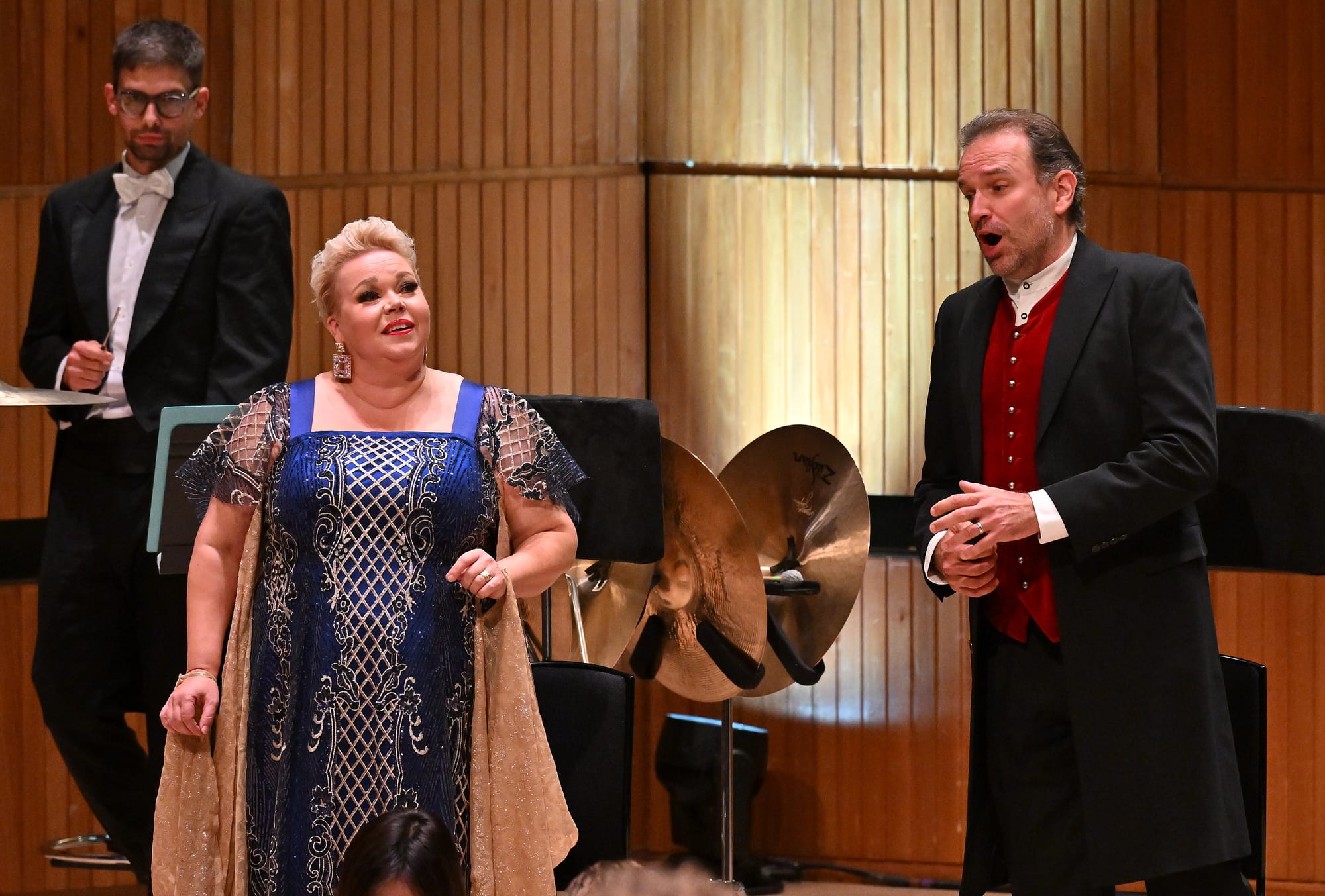An unforgettable Sibelius Kullervo and a major UK premiere
A major UK premiere and a Kullervo for the ages

Nordic Soundscapes: Sigfúsdóttir, Grieg, Sibelius Stephen Hough (piano); Johanna Eusanen (soprano); Tommi Hakala (baritone); YL Male Choir; Philharmonia Orchestra / Santtu-Mathias Rouvali (conductor). Royal Festival Hall, London, 26.09.2024
María Huld Markan Sigfúsdóttir Oceans (2018, London premiere)
Grieg Piano Concerto in A minor, Op. 16 (1868)
Sibelius Kullervo, Op. 7 (1892)
What a way to start the Philharmonia’s Nordic Soundscapes series.
The music of María Huld Markan Sigfúsdóttir is remarkable. Booklet note annnotator Andrew Mellor also penned a significant book, Nordic Silence (Yale University Press, 2022) in which he explains Sigfúsdóttir’s placement:
In 2018, the Iceland Symphony Orchestra began to chronicle an oustanding new generation of Icelandic orchestral composers with a series of recordings. Across all three albums, titled Emergence, Recurrence, and Occurrence, are works by the composers María Huld Maran Sigfúsdótti, Hlynur Adils Vilmarsson, Anna Thorvaldsdottir, Páll Ragnar Pálsson, Haukur Tómasson, Ðuriður Jómsdóttir, Magnús Blöndal Johansson, Veronique Vaka and Dniel Bjarnason (also the ocnductor on all trhee). (page 139).
Mellor adds, “The vast majority of the scores included are slow by anyone’s definition." In his booklet note here, Mellor describes Sigfüsdóttir as a member of the “First Icelandic School – a generation of millenialist composers whose music tends twads the slow and vaporous, mining atmospheric, beguiling and often spectral sounds from the symphony orchestra that speak of their nation’s topography, weather systems and unavoidable connection to geological timescales”.
Slow and monumental would seem to sum it up. Sigfúsdóttir's pieces Aequora and Spirals certainly demonstrate this, but Oceans does slow on a more monolithic scale.
In Oceans, texture and orchstration sit on an equal footing with harmony, somehing which seems to emphasise harmonic arrival points. Much of the music shifts, or more accurately transforms slowly into something else. The orchestra is huge (eight double-basses, four percussioniss among them) but the sounds are often hyper-delicate – the high violin beginning, for example superbly sustained by the Philharmonia. For all of its monolithic gesures, though, there is melody at the heart of Oceans. It might be slow-moving, but it emerges as if from a crysallis, birthed into toanal strucures that quickly twist and mutate. The music occasionally ‘arrives’ somewhere, before defocusing again, all held wih in an austere glacial beauty. There is a moment that seems o point to Wagner, both generally and at one point specifically towaards Parsifal (I heard it both in the concert and listening to the YouTube of the World Premiere in 2018). Most surprising is a three-note unaccompanied solo tuba that seemed to be of vital significance. So it seemed in Rouvali’s reading, anyway (it seems less so in the World Premiere). Rouavli brought out a rhythm that seems to take on the role of a Bergian Hauptrhhmus on bass drum, underpinning oceanic swells that move from gloom to radiance. The piece ends queltly, hauntingly, an invitation for us to silently comtemplae teh magnificence of Gaia’s oceans: so why the instant applause I don’t know. Rouvali set up the perfect atmosphere; this was a fine performance of a significant piece. I look foward to exploring more of Sigfúsdóttir's music.
My last encounter with Stephen Hough was in the Poly Theatre in Beijing (a programmethat included his own Partita for piano: the report of my trip to the Chinese capital’s 2023 festival is available online here). Here in London, in Grieg, the results were somewhat more mixed. Rouvali showd himself a concerto partner par excellence, with Hough at every micro-juncture. Hough did show much sense of freedom in the first movement, but a few passages revealed he was not completely inside the music as yet; best was the cadenza, a finely wrought and intelligent reading. Interestingly, when Alice Sara Ott played this concerto with the Philharmonia just over a decade ago, an interpretation that foregrounded the Liszian elements of the score; Hough’s solution felt more satisfactory.
The Philharmonia’s muted strings did sound fabulous for the opening of the slow movement, and Jonathan Weigle’s cello sang deeply. This did not feel entirely settled still, and there was surely no need for the attempted applause between the second and last movements (there had been applause also after the first). The finale did exude fresh air, though, a lovely, pointed dance. The brass department felt decidedly trombone-led; in amongst all of this, Hough and Rouvali conspired to create a moment of great peace. One encore, an old favouite: Christian Sinding’s Rustle of Spring Op. 32/3 (most often known by its German title, Frühlingsrauschen), in a most appealing performance.
Allow me to indulge in a personal favourite performance of this piece, from Joseph Cooper:
There were almost zero caveats for the Kullervo though. If I have occasionally harboured doubts as to Rouvali’s premiership of the Philharmonia, his proved that in the right repertoire he is completely and utterly convincing. His grasp of the score was evident throughout – and it’s a big score. With large orchestra and lasting some 81 minutes here. The choir was the YL Male Voice Choir: ‘YL’ stands for Ylioppilaskunnan Laulajat, Finland’s best-known male voice choir and one of the finest shoirs I have ever heard. There is a complete mastery of range (no straining as the voices go up) and perfect balance and timbral mix. Their sound is simply beyond compare.
The Philharmonia rose to the challenges of Sibelius’ huge score. An early work, (Sibelius was not yet 30 when he wrote it), it is a celebration fo Nordic nationalism and myth. First performed in Helsinki in April 1892, it was a seminal part of Finland’s path to independence. The use of folk-like melodies is no acciden: when Sibelius returned to Helsinki from Vienna, he visited the folk singer Larin Paraske, notaing what he heard.
The long first movement (Introduction) needs a clear head at the helm, and Rouvali paced it superbly, melodies striding along, ebullience present and correct. There is no missing Sibelius’ signature here at times, particularly perhaps in the woodwind writing. This was a very, very powerful statement; the heartachingly muted strings at the opening of the second movement (Kullervo’s Youth‘’) beautifully phased. Again, pacing seemed perfect from Rouvali – perhaps just a touch more intensity would have sealed the deal. But that was more than counterbalanced by the simply superb clarinet solos . Nost of all it was the sense of organic growth, a vet Sibelian trait, that clinched it, and that emanated from Rouvali’s foresight.

The choir enters in the third movement (‘Kullervo and his Sister’), a narrator with the two soloists as the characters in a tale of incest. If Johanna Rusanen seemed over-vibratoed at first, she did settle, a feisty and strong woman in the story; Tommi Hakala was confident and forthright of voice throughout. Certainly, neither compromised at any point in this performance. Rouvali’s way with the orchestra was to bring out the vividness of the scoring and the vivacity of the music itself; a trait that recurred in the raw dances of the fourth movement (‘Kullervo goes to War’) that transmogrify themselves into something far darker (along with some remarkable scoring, beautifully delivered in Technicolour by the Philharmonia players).
Finally,’Kullervo’s Death’. Here, the choir took on an almost ritualistic aspect in the repetitions of ‘Kullervo, Kalervon poika’ (Kullervo, Kalervo’s offspring). Here,Nature is animated (the grass weeps) and there is a sentient sword that perhaps recalls Wagner’s Nothung. From full dynamic spectrum to silences pregnant with energy, this was an unforgettable conclusion to a performance by the Philharmonia at the height fo their powers.
A most memorable evening, a major UK premiere and a Kullervo for the ages.
We previously considered Osmo Vänskä's Minnesota BIS Kullervo here, and the Vänskä complete Sibelius symphonies on BIS here.
